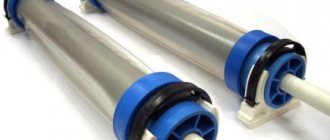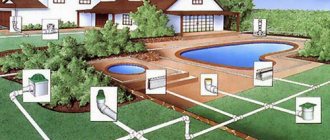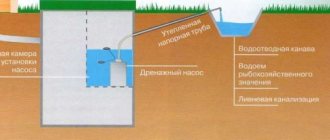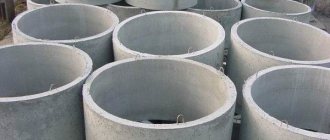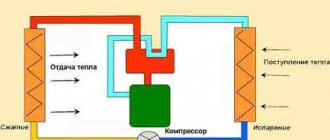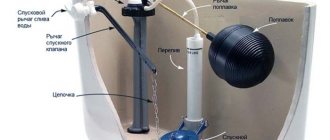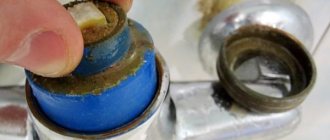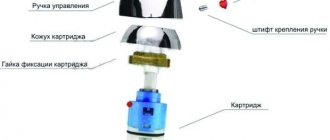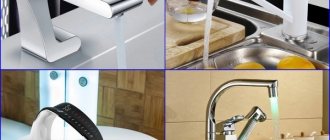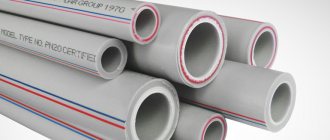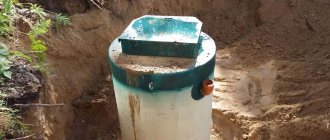Purpose and principle of operation
The compact device serves as a water jet limiter and is a small device equipped with a mesh filter. Some users who have a faucet installed dismantle the aerator, believing that it obstructs the passage of water and reduces the flow rate. The purpose of the device is to clean, normalize and save water. Functions performed by the aerator:
- Restricting water flow without loss of intensity.
- Normalization of supply and regulation of jet quality.
- Purification of water from large particles of debris and impurities.
- Saturation of the flow with oxygen, weathering of chlorine.
- Orderly delivery without splashing jets.
Visually, the flow becomes milky soft, the water envelops the object under the tap, which facilitates comfortable washing of dishes and kitchen utensils from detergent residues. The adjustable jet does not “split” into hundreds of small sprays, which fly away in different directions under pressure.
An aerator for a mixer is otherwise called a water economizer and belongs to the category of modern gadgets. The principle of operation is to mix water and air inside the device. A whitish-foamy stream is formed as a result of saturation with oxygen ions when passing through a disk or slot-type filtration system.
Air enters the economizer due to the difference in internal and external pressure at the narrowest section of the device. As a result, the stream flowing from the tap consists of one third water and two thirds air bubbles. This is facilitated by the special design of the aerator, consisting of the following elements:
- The mixer nozzle is placed in a sealed housing.
- The mesh part is made in the form of filtration membranes.
- Gasket made of high-quality rubber or elastic silicone.
In the cylindrical module of the device, mesh filters are laid in a certain sequence. The first two limiters direct the jet, and the rest are responsible for mixing it with oxygen bubbles. The structurally simple device effectively filters water and regulates liquid flow. Depending on the brand of economizer manufacturer, the design of the nozzle may vary slightly, but the basis of any model is the body, a flexible gasket and a system of mesh filters with cells of different shapes and diameters. Advantages of using a faucet with an aerator:
- Significant water savings – efficiency of at least 50%.
- Formation of a uniform flow without splashes and water hammer.
- Prevents the formation of blockages in the mixing element.
- Maintaining a jet intensity that is comfortable for the user.
- Operating modes for everyday consumption and quick refilling.
- Easy installation of the nozzle on the faucet without special equipment.
- Effective filtration of water when passing through membranes.
- Reducing the amount of lime deposits inside the tap.
- Reduced flow noise level due to mixing with air.
- Universal use on mixers of different models.
- Possibility of regulation (direction) of fluid flow.
- Aesthetically attractive appearance and long service life.
Faucet aerators do not have any significant disadvantages. But the service life of the nozzle is affected by the quality of the plumbing system. If the pipes have not been replaced for many years, solid particles enter the water and contaminate the economizer strainers. After some time, it is necessary to replace the aerator with a new device. Another disadvantage of aerators is that the time it takes to fill containers with water increases, since part of the volume of the stream consists of air bubbles.
To achieve effective water saving and high quality, you need to periodically clean the nozzle from dirt and constantly monitor the working condition of the gadget.
How does an aerator work and why does it save water?
The device gets its name from the process it creates. “Aeration” translated from Greek means “air”, and the process itself is the natural saturation of water flows with air.
It is carried out by passing bubbles through a liquid.
Due to the fact that during the aeration process the air is in close contact with water, the stream is more uniform and at the same time soft
The main purpose of the aerator attachment on the faucet is to reduce water consumption. According to some reports, using this simple device you can reduce water consumption by up to 50%. Without an aerator, water flows from the tap in a continuous stream.
And entering through the nozzle, saturated with air bubbles, the stream loses its elasticity, acquiring a seething appearance. A soft spray of water does not splash, hitting the walls of the sink or dishes, but smoothly washes them.
This technology is not new. But over the decades it has undergone a number of changes. The first models of aerators were devices in the form of metal disks equipped with holes. But despite the presence of a protective screen, such devices quickly clogged and failed.
Modern models of nozzles are equipped with perforated discs, the holes of which are much larger, and multi-stage filtration systems.
Despite the fact that modern nozzles have larger hole sizes, they also become clogged over time with limescale deposits that are present in tap water.
Modern models are designs that include three main elements:
- The housing, made of plastic or metal, protects the structure from mechanical damage.
- A modular system in the form of a slotted cartridge with slots or a disk reflector with small holes is responsible for mixing water with air and at the same time acts as a water limiter.
- A sealing ring made of dense rubber ensures sealing of the connection between the nozzle and the water tap.
The filter of the device is a set of fine-mesh meshes placed in a cylindrical glass sequentially one after another. The first two layers carry out rough water purification and at the same time set the direction of the stream, the next ones mix water with air.
The designs of aerators from different manufacturers may vary slightly. In the simplest models, the nozzle takes the form of a plastic liner; in more expensive modernized devices, it is a multi-stage mesh filter.
The flow of water, passing through thin cracks, crashes into the disk and breaks into tiny droplets, which, in turn, mix with air
The nozzle is fixed to the mixer using a threaded connection. On sale you can find nozzles with both an internal thread with a diameter of 22 mm and an external cross-section of 24 mm. They are designed for installation on bathtub, washbasin and kitchen sink faucets.
When installing an aerator on a faucet, the consumer’s only task is to determine, when purchasing a nozzle, which thread is provided on the faucet.
If the faucet spout is not equipped with a thread, it will be possible to install the aerator only after replacing the mixer.
Types of faucet aerators
Almost all manufacturers of sanitary products install a fixed diffuser on faucets as standard for economical consumption of water. The nozzle operates in the factory-defined mode. Users can remove the stock unit and install a modern economizer with improved performance, high efficiency and longer service life. Based on the type of design and method of dispersing the water jet, aerators are classified into vacuum, rotary devices and nozzles with LED backlighting.
Vacuum
Vacuum-type devices are equipped with a special valve. This design increases the pressure during jet emission and saves water by 4 times. At the point of attachment to the tap, the use of a valve ensures a narrowing of the water channel. An area of high pressure is formed in the upper part of the device, air is taken in in the central segment, and a low pressure area is formed below and an air-water flow occurs at the outlet. Due to the pressure difference, a multiple aeration effect is achieved. Advantages of vacuum devices:
- Optimal conservation of water resources.
- Easy installation and dismantling of the device.
- Strong saturation of the flow with oxygen.
- High power and intensity of the jet.
Vacuum designs are more expensive than other models, which can be called a disadvantage of economizers, but they demonstrate the highest efficiency in water saving - an average of 1.1 liters per minute. A special valve compresses water under pressure and a powerful, intense flow is formed at the outlet.
Rotary (adjustable)
Flexible nozzles allow the user to direct and adjust the water stream without turning the faucet. Adjustable aerators operate in two modes - as a spray with a fine dispersion of liquid or with an intense jet of water. Features of the rotary model:
- The design is equipped with a flexible ball - the element helps to redirect the flow in the desired direction.
- Equipping the aerator nozzle on the faucet with a flexible joint-tube, which combines two separate parts of the device.
- Regulating the flow force, which allows you to quickly fill large tanks, for example, bathtubs.
- Some models of sprayers are equipped with movable watering cans, which allows you to move the stream within the sink in the desired direction.
The flexible type structure is rigidly fixed at the top of the crane. Using a swivel or hose type adapter, the flow is regulated or redirected. Such devices are very convenient for washing dishes, sinks, and installation in the shower. An important condition is the tightness of the connection between the two parts of the nozzle with a flexible adapter (hose, hinge, tube).
Backlit
There are “smart” water-saving gadgets on sale with an interesting decorative function of illuminating the water jet, made using diodes of different shades. The backlight turns on when water passes through the economizer. The presence of decorative lighting does not affect water savings. Advantages and features of the device:
- In most models, the light source is represented by diodes.
- Multi-colored lighting does not depend on energy consumption.
- Light sources operate by rotating a turbine.
- Installation on the spout is no different from installation of other models.
The presence of the jet illumination function affects the cost of the economizer. It makes sense to install such aerators on high-quality, expensive faucets. The diodes color the flow in different shades depending on the water temperature - green, blue, red.
In models with illumination, you can not only highlight the jet, but also set the flow to a certain temperature, which is maintained automatically. To do this, the aerator must be equipped with a thermostat.
Advantages and disadvantages of an innovative device
The main advantages of the aerator include:
- Saving water consumption. In normal mode, up to 15 liters of water can flow through the tap in one minute. If you equip it with a nozzle, the flow rate can be reduced by half to 6-7 liters per minute.
- Reducing the noise level of plumbing equipment. It has been noticed that water supplied with air makes less noise.
- Improving water quality. During the process of aeration, water is saturated with oxygen. This reduces the percentage of chlorine, which is hazardous to human health. Water passed through an aerator better washes away detergents used when bathing or washing dishes.
The cost of a bath aerator, depending on the manufacturer, ranges from 2 to 10 dollars, so the purchase of such a device will not significantly affect the family budget
You can install the device yourself without involving specialists for this purpose.
If we talk about the disadvantages of the device, then it is worth noting the following points:
- The need for frequent repairs or even complete replacement of the device if the water quality in the centralized system is low. If the pipes in the house are old, then the aerator will have to be replaced every year.
- A decrease in the volume of incoming water may affect the rate at which containers (sinks, bathtubs, large pans) are filled.
Otherwise, this device has no shortcomings.
What material is most practical?
To make aerators, manufacturers use different materials that are resistant to constant contact with water. The nickel or chrome coating applied to the body of the device protects the metal well from corrosion. Based on the material used, aerators are classified into several types:
- Plastic models. A budget option, since the devices are inexpensive. During long-term use, the plastic does not stick to the tap. If replacement is necessary, the aerator can be easily dismantled and a new device installed in its place. The material does not corrode from prolonged contact with an aqueous environment. Disadvantage: plastic products are not resistant to mechanical loads; the material is exposed to impurities contained in water.
- Brass and bronze fixtures. Such models are more expensive than plastic ones, but have high strength and durability. When exposed to water, metal alloys do not rust. Products in this category are the most practical for everyday use. Brass economizers are ideal for installation in the kitchen and bathroom; there are options with adjustable water supply.
- Ceramic devices. Such devices can last 5-7 years without replacement. Impurities and lime deposits are deposited on ceramics in much smaller quantities. Ceramic aerators are not subject to corrosive processes; the natural material does not contain toxins, therefore it is environmentally friendly. Ceramic models are inferior in strength to metal products; a strong blow can damage the aerator.
- Stainless steel or metal with anti-corrosion nickel or chrome coating. Steel economizers are highly durable and, if coated, can withstand constant exposure to water. The metal device is not “afraid” of mechanical loads; it cannot be broken and is problematic to break. The only drawback of such products is that the aerator can stick to the faucet spout. To remove it, you need pliers.
Some manufacturers produce extruded aluminum faucet attachments. The devices are characterized by low mechanical strength. Already during the installation process, you can accidentally damage the fragile structure. You should discard such products - they are short-lived. Metal products are in greatest demand among buyers, and a plastic aerator is suitable as an inexpensive purchase.
Brass
Metal
Plastic
Materials from which aerators are made
The biggest and most significant difference, besides the shape of the aerators, is the material from which it is made. Today, aerators are made from three types of materials:
Metal
Aerators are less suitable for use due to their impracticality. At the bottom of this model there is a mesh, on which, over time, plaque from lime deposits and salts forms.
Plastic
Such aerators, compared to metal ones, clog more slowly and are easier to clean. The most common option today.
Ceramic
More difficult to produce and more expensive, but at the same time the most reliable. They practically do not clog and do not deteriorate over time.
What to look for when choosing
Based on the type of fastening, nozzles with internal and external threads are distinguished. In the first case, it is important to use economizers for installation on kitchen taps and mixers in the bathroom. To install a water-saving device on a shower, it is more convenient to use aerators with external threads. They are easy to screw onto the tap, but it is important not to make a mistake with the thread size:
- If the parameter 24 mm is specified, this is an external thread, such aerators are comfortable to use in bathtubs and showers.
- The thread with a diameter of 22 mm is internal, the devices are screwed into faucets in the kitchen, and faucets for washbasins in bathrooms.
- There are aerators with internal and external M28 threads on sale, which are suitable for faucets with a large spout diameter.
- For a non-standard faucet, for example, a rectangular one, you need to choose aerators designed for a shaped spout.
If the faucet does not have threads, you need to replace it with a faucet with an internal or external threaded connection. Leading manufacturers of aeration equipment produce special devices for non-standard mixer models.
Based on the installation method, water economizers are classified into internal and external. To mount an internal aerator (it has an external thread), the structure is placed in the faucet spout. The device does not focus attention or change the design of the mixer.
Devices for external installation are screwed onto the spout of the faucet - the aerator has an internal threaded connection. Such models are mainly made of brass or stainless steel. They are easier to install and dismantle to clean the filters. Availability of additional functions in economizers:
- Purification of water from coarse impurities. Thanks to a mesh membrane system, aerators remove solid particles and chlorine from the liquid, making the water softer, palatable, and suitable for cooking without prior settling.
- Removing splashes. A kitchen faucet or bathroom mixer that is not equipped with an economizer sprays water in different directions when there is an intense flow of water. Installing a directed flow aerator quickly solves this problem.
- Changing the water supply mode. A classic aerator simply supplies water enriched with oxygen. Special models with a jet intensity control function allow you to switch from aeration to a regular jet.
- One-click feed. Models with this option can be installed on water supply systems equipped with water return valves. An aerated stream of water flows from the faucet for a certain time when you press a button, after which the flow stops.
In order for the faucet attachment to last longer, you need to choose an aerator made from high-quality durable materials. You should first check the presence of a threaded connection on the faucet and measure the size of the faucet spout. When purchasing, it is important not to confuse which aerator is suitable for plumbing - with internal or external threads.
What are we talking about?
Surely, anyone who has at least once laid their eyes on household taps or mixers has paid attention to a certain detail where they end.
Let us hasten to assure that the filter role they perform is only one of the tasks assigned to these devices. Their main purpose is to change the structure of the outgoing jet. So, thanks to aerators at the outlet you can get:
- Volumetric spray without splashing;
- Intense flow;
- Numerous small jets.
These options can be either the only options for aerators or one of a set. It all depends on the model and, as a result, the cost.
For the most part, aerators have a cylindrical shape, although for the sake of designers’ ideas or harmony with a particular style of kitchens, bathrooms or other rooms, they can have rather intricate geometry.
Installation Tips
If, due to the design features of the faucet, it is difficult to select an aerator with a suitable thread, you can use a special adapter. To properly install the device, you must adhere to the following recommendations:
- The water economizer kit includes a sealing rubber gasket. It prevents leaks and serves as a hermetically sealed connection between the aerator and faucet. First install the gasket. If it is not included in the kit, the seal is purchased separately.
- If it is necessary to install an adapter from thread to thread, select a part made of the same material as the aerator. If an adapter is used, rubber seals are installed on both sides of the auxiliary part.
- The aerator is carefully screwed (or screwed depending on the type of thread) into the faucet spout. To avoid scratching the faucet, the legs of the pliers are wrapped with a rag, electrical tape or other sealant.
The thread is tightened with moderate force, but not weakly. The result should be a tight, airtight connection through which no water can leak. Before operating the device, check the operation of the mixer for leaks. In the shower, the aerator is installed in the same way; it is more convenient to use devices with internal threads.
Advantages and disadvantages
Almost all the advantages of the aerator stem from the separation of the stream and its saturation with oxygen.
- The first and most important plus for most owners is saving water. By breaking up the jet, a flow is formed that consumes 6-8 times less water from the water supply network, without reducing the pressure. You just need to pay attention that this plus is relevant only if there is sufficient pressure in the internal network. If the pressure is low, which is especially important in small towns in Russia, then you need to take into account that the aerator creates additional resistance, which can “kill” what is left of the pressure.
- A much less noticeable, but no less significant point is the lesser impact of the jet on the skin. The human body is designed in such a way that a stream saturated with air has a beneficial effect on the surface epithelium. In addition, the aerator traps large salt particles, thereby further reducing the mechanical impact of the jet on the skin.
- This is an additional filter that traps particles of salt, rust and scale. In the conditions of modern deterioration of engineering communications, this is not an extra step at all.
- An air-saturated jet makes it easier and easier to wash dirty dishes. This means the amount of time spent on this unpleasant activity is reduced and water consumption is reduced.
- The noise level is reduced. A large number of small jets make much less noise than one large jet of the same volume.
What does an aerator for a mixer look like
? The disadvantages are mainly related to the material:
- Poor quality aerators can stick to the faucet surface. In order to change such a device, you will have to buy the entire mixer, and this is an additional expense.
- In cities with heavily worn out water supply networks, the device will have to be replaced or cleaned frequently. About once every 1-3 months. It's unpleasant, but necessary. And if you consider that the water supply network is worn out in 80% of the cities of our country, then the conclusions suggest themselves.
- With low pressure, an aerator is not the best idea, since it will reduce the already imperfect stream.
Rules of care
In order for the device for economical water consumption to work correctly, it is necessary to ensure timely cleaning of the filter system from clogging. The quality and intensity of the flow depends on the serviceability of the device. Over time, solid particles and plumbing debris accumulate in the mesh membranes of the aerator, and the device ceases to perform its functions. The main signs of malfunctions are weak pressure, a minimum number of air bubbles, unevenness of the jet and the absence of a characteristic hissing sound. The procedure for dismantling, cleaning and reinstalling the device is as follows:
- Using a mechanic's wrench or pliers with wrapped paws, carefully unscrew the aerator, being careful not to damage the tip of the tap. You can wrap the head of the device with a rag.
- You need to use a 22mm wrench, grabbing the device by the flat edges located diametrically opposite each other. The aerator must be turned clockwise.
- After this, pry up and pull out the rubber seal from the mixer, rinse thoroughly with water and check its condition. A worn or deformed gasket must be replaced.
- The aerator is sequentially disassembled, removing the filters from the housing. Small holes in the spherical mesh element are cleaned with an awl or a needle and washed under high pressure of water.
- If caked-on salt deposits remain on the filters, they must be removed using a special compound. For example, you can place the mesh in apple cider vinegar or detergent.
- After cleaning, the aerator is assembled in the reverse order and screwed into the tap or mixer counterclockwise. To do this, use pliers, a wrench or pliers.
Rubber seals cannot be washed with chemicals. If the gaskets are worn out, it is not recommended to put them back in the aerator - the products must be replaced. When tightening the device, do not apply too much force to the economizer so as not to strip the thread. Before use, check the tightness of the connections and, if necessary, tighten the device a little more. The process of cleaning or replacing the aerator is not difficult.
The economizer works by mixing water and air. As a result, the device makes noise during operation, which causes some discomfort. To reduce the noise level of the device, it is recommended to check the condition of the filters. If they become dirty, the flow dries up, and the water can “swirl” in places where debris accumulates the most. This creates noise, which can be reduced by cleaning the device.
Cleaning the aerator mesh from rust
First, you need to wash each aerator mesh under running water using any detergent with a hard brush or an old toothbrush.
Mechanically, fine grains of sand and dirt are easily removed from the mesh. But a coating of rust, covering half or more of the mesh cells, will remain.
To remove the remaining rust deposits, you need to use a chemical cleaning method. For these purposes, any detergent for washing plumbing products that removes rust, for example Sanox, is suitable.
All parts of the aerator must be placed in a suitable container and filled with detergent. After 15-20 minutes, the rust from the surface of the part should disappear, otherwise you need to wait longer. When traces of rust disappear, the parts should be washed in running water.
As you can see in the photo, the aerator parts after treatment in the Sanox detergent began to look like new.
The aerator nets must be installed in the sequence shown in the photograph. It has been noticed in practice that in order for the aerator to operate with very low water pressure in the water supply system, the fine mesh during assembly must be oriented in such a way that the wires forming the cells of one mesh are oriented relative to the wires of the adjacent mesh at an angle of 45°.
After cleaning the mesh, assembling and installing the aerator on the mixer, a stream of water from the tap ran filled with bubbles, making a characteristic hissing sound. Thanks to cleaning the mesh with my own hands, the aerator began to work like new.
Popular manufacturers
Many companies producing sanitary equipment are engaged in the manufacture of aerators for faucets. Water-saving devices must be of high quality, reliable and durable. The products of the following companies are in wide demand among consumers:
- The German manufacturer Grohe produces high-quality economizers that are tested at all production stages. The declared service life of faucet attachments is from 5, subject to proper installation and maintenance. The cost of products varies from 350 to 1000 rubles.
- Finnish aerators produced by Oras are in greatest demand among buyers due to their high quality and reasonable price (250-500 rubles). The manufacturer also produces ready-made kits, which include sink faucets equipped with aerators. Finnish products have a good filter system.
- Aerators for faucets of the Timo brand (Finland) have gained wide popularity. The manufacturer claims a 5-year warranty period for the products. The models of the Finnish brand are interesting in terms of design; high-quality materials are used for their production; the product line includes water-saving devices of different colors. The average price is up to 500 rubles.
Good aerators are produced by the French company Jacob Delafon. According to consumer reviews, domestically produced aerators are much cheaper than imported models, but do not have a long service life. In general, water limiters show high savings and are easy to install and dismantle. The use of faucet attachments does not interfere with the comfortable use of water.
Grohe
Jacob Delafon
Oras
Timo
Aerator care: cleaning and replacement
For your faucet aerator to work properly, you need to keep it clean. To do this, you will need to periodically clean the nozzle.
The aerator must be cleaned regularly, otherwise the water pressure will decrease significantly
When is it necessary to clean the aerator?
- Reducing water pressure.
- No hissing of running tap water.
If the problems with the aerator coincide with the above indications, then the device needs to be cleaned or replaced.
About optimal water consumption
The main points have already been discussed, all that remains is to clarify a small detail. When choosing an aerator, you should use common sense. There is no need to install bronze devices throughout the house. In some places, for example, in the bathroom, plastic ones will look quite good, depending on the pressure, of course.
In the case of a bathtub or shower, installing an aerator can reduce ease of use. The recommended flow rate for a shower is 3-5 l/min, and for a kitchen you will need up to 5 l/min. When using a rotary aerator, you can reduce the flow rate a little more, but with caution.
Lawn aeration: specifics and methods of aeration, verticulation and scarification of lawns
A neat, thick and well-groomed lawn is a kind of face of the local area, which quite often forms the basis of landscape design. It doesn’t matter whether the project was developed by a design firm or implemented with your own hands.
Aeration, verticulation and scarification of lawns.
However, to maintain the lawn in proper order, several conditions must be met. Thus, lawn grass requires regular watering, fertilizers and access to oxygen. Lawn aeration can provide all this.
Lawn after winter: (read more)
Lawn aeration is piercing the turf, aimed at improving gas exchange between atmospheric air and soil.
You need to combat compacted soil with tubular aeration - using a mechanical aerator.
Aeration is carried out twice a year, in spring and autumn.This procedure has a beneficial effect on the growth and development of the lawn, helps prevent diseases, rotting of the lawn (in case of excessive moisture during the rainy period) and allows It is better for the lawn to renew itself, maintaining a fresh and healthy appearance.
In the spring, this procedure is carried out at a time when the snow has just melted and the surface of the earth has begun to dry out. If there is stagnation of water on the lawn or pieces of it are trampled, then aeration is carried out in the spring, and in summer.
Note! In rainy weather, aeration helps dry out excess moisture and prevent rotting of roots, and in drought, it will increase the efficiency of irrigation.
What the experts say
On sale you can find a large number of different versions of aerators, the cost of some is within several tens of rubles. Some are effective, others are not, despite using the same production technology. You should choose the offer of well-known manufacturers, since in this case you can be satisfied with the result obtained.
Marina.
When looking for a way to significantly reduce water consumption, you should pay attention to aerators. I note that 1 liter of water remains 1 liter of water, but the consumption is reduced when washing dishes or taking a shower. The effect has been proven by numerous studies.
Nikolai.
I bought an illuminated aerator, installed it, and immediately couldn’t get enough of the results. However, as it turned out, in practice backlighting is not needed, since it is poorly visible in the light, and there is no point in using the faucet in the dark.
Catherine.
Manufacturing materials
Manufacturing materials can be divided into three large groups: various types of plastic, aluminum and brass or stainless steel. In general, each material has its own advantages and disadvantages.
Plastic
Plastic is a very controversial material for an aerator. Among plumbers, the debate continues about which aerator is better at a low price: plastic or aluminum. But the disputes are more likely related to the traditional perception of plastic as a fragile, unreliable metal in our country.
To some extent this is true. A rare plastic aerator lasts longer than 2-3 years, but they cost very little and do not stick to the faucet head. That is, at a low price, they are easy to replace, whereas problems may arise with aluminum devices.
Aluminum
Aluminum is approximately in the same price category as plastic. But this is nothing but metal. Which inspires confidence among a number of plumbers. But aluminum has a property due to which it is still not recommended to install such aerators, preferring plastic instead.
With prolonged use, especially with alternating hot and cold water, aluminum sticks to the faucet head and literally becomes part of the mixer.
It will no longer be possible to replace such an aerator after 1-2 years of operation, and changing it every six months is too expensive and not profitable.
And a stuck aerator is another center for scale crystallization and salt deposits. Year after year, the device's throughput will decrease more and more. So isn’t it better to buy fragile plastic so that you can replace it later without any problems, rather than having to worry about replacing the faucet?
Brass
Brass and stainless steel aerators are the best option. These devices do not stick, last a long time, and are easy to use. The only drawback is the price: from 30 to 200 rubles for average plastic and aluminum aerators versus 500-700 rubles for brass or stainless steel ones.
These devices have no other disadvantages. But precisely because of the price, it is rare that a manufacturer will put such a model on a mixer of its own production.
Additional device features
The aerator has only two additional functions, in addition to those already listed.
- Aerators with adjustable jet. These are nozzles made in the body of a flexible metal hose or on hinges. With such nozzles you can direct the jet to dirty dishes within the sink without any problems. This device does not have any special design features, although it is more expensive. Whether such a function is needed or not is up to everyone to decide for themselves.
- The second function is much more useless. This is a water jet illumination system. Why might it be useful? To improve the interior or as an additional source of light at night, so as not to blind your eyes with a bright lamp. The usefulness of the backlight is questionable, but such aerators are quite popular.
Another feature worth mentioning is the popularity of fraudulent schemes with this device. Just a couple of years ago, the entire Internet was full of advertisements for a device that could reduce water consumption. This device was the already familiar aerator, only it was sold for fabulous money.
Today, sellers are already using a little fraud, highlighting a special type of economical aerator. There are no smart parts in this device that can save more than a simple quality device without such a name. Therefore, any name with the word “economical” is more of a publicity stunt than reality.
Conclusion
As we have learned, there are many different types of attachments available today. In addition to classic faucet attachments that save water, there are filters, lights and other devices. Based on this, before buying a device, you need to decide on the main tasks that it should solve, since in some cases a magnetic attachment on a faucet with a carbon filter is more appropriate, in others a simple aerator is enough to save water.
From the video in this article you can get some additional information on this topic.
